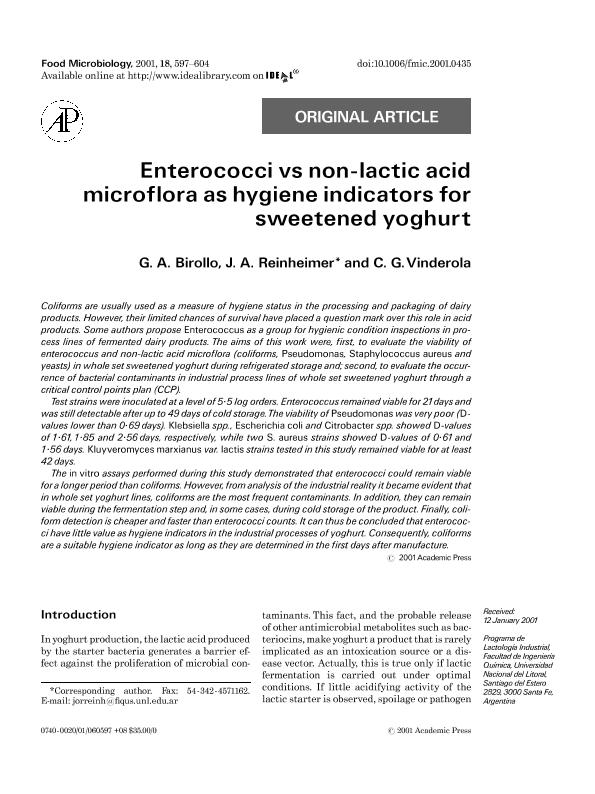Mostrar el registro sencillo del ítem
dc.contributor.author
Birollo, G. A.
dc.contributor.author
Reinheimer, Jorge Alberto

dc.contributor.author
Vinderola, Celso Gabriel

dc.date.available
2018-03-07T18:16:16Z
dc.date.issued
2001-06
dc.identifier.citation
Birollo, G. A.; Reinheimer, Jorge Alberto; Vinderola, Celso Gabriel; Enterococci vs non-lactic acid microflora as hygiene indicators for sweetened yoghurt; Academic Press Ltd - Elsevier Science Ltd; Food Microbiology; 18; 6; 6-2001; 597-604
dc.identifier.issn
0740-0020
dc.identifier.uri
http://hdl.handle.net/11336/38144
dc.description.abstract
Coliforms are usually used as a measure of hygiene status in the processing and packaging of dairy products. However, their limited chances of survival have placed a question mark over this role in acid products. Some authors propose Enterococcus as a group for hygienic condition inspections in process lines of fermented dairy products. The aims of this work were, first, to evaluate the viability of enterococcus and non-lactic acid microflora (coliforms, Pseudomonas, Staphylococcus aureus and yeasts) in whole set sweetened yoghurt during refrigerated storage and Second, to evaluate the occurrence of bacterial contaminants in industrial process lines of whole set sweetened yoghurt through a critical control points plan (CCP). Test strains were inoculated at a level of 5.5 log orders. Enterococcus remained viable for 21 days and was still detectable after up to 49 days of cold storage. The viability of Pseudomonas was very poor (D-values lower than 0.69 days). Klebsiella spp., Escherichia coli and Citrobacter spp. showed D-values of 1.61, 1.85 and 2.56 days, respectively, while two S. aureus strains showed D-values of 0.61 and 1.56 days. Kluyveromyces marxianus var. lactis strains tested in this study remained viable for at least 42 days. The in vitro assays performed during this study demonstrated that enterococci could remain viable for a longer period than coliforms. However, from analysis of the industrial reality it became evident that in whole set yoghurt lines, coliforms are the most frequent contaminants. In addition, they can remain viable during the fermentation step and, in some cases, during cold storage of the product. Finally, coliform detection is cheaper and faster than enterococci counts. It can thus be concluded that enterococci have little value as hygiene indicators in the industrial processes of yoghurt. Consequently, coliforms are a suitable hygiene indicator as long as they are determined in the first days after manufacture.
dc.format
application/pdf
dc.language.iso
eng
dc.publisher
Academic Press Ltd - Elsevier Science Ltd

dc.rights
info:eu-repo/semantics/openAccess
dc.rights.uri
https://creativecommons.org/licenses/by-nc-nd/2.5/ar/
dc.subject
Enterococci
dc.subject
Food Hygiene
dc.subject
Indicators
dc.subject.classification
Alimentos y Bebidas

dc.subject.classification
Otras Ingenierías y Tecnologías

dc.subject.classification
INGENIERÍAS Y TECNOLOGÍAS

dc.title
Enterococci vs non-lactic acid microflora as hygiene indicators for sweetened yoghurt
dc.type
info:eu-repo/semantics/article
dc.type
info:ar-repo/semantics/artículo
dc.type
info:eu-repo/semantics/publishedVersion
dc.date.updated
2018-03-06T17:03:13Z
dc.journal.volume
18
dc.journal.number
6
dc.journal.pagination
597-604
dc.journal.pais
Estados Unidos

dc.description.fil
Fil: Birollo, G. A.. Universidad Nacional del Litoral. Facultad de Ingeniería Química. Prog.de Lactología Industrial; Argentina
dc.description.fil
Fil: Reinheimer, Jorge Alberto. Universidad Nacional del Litoral. Facultad de Ingeniería Química. Prog.de Lactología Industrial; Argentina. Consejo Nacional de Investigaciones Científicas y Técnicas; Argentina
dc.description.fil
Fil: Vinderola, Celso Gabriel. Universidad Nacional del Litoral. Facultad de Ingeniería Química. Prog.de Lactología Industrial; Argentina. Consejo Nacional de Investigaciones Científicas y Técnicas; Argentina
dc.journal.title
Food Microbiology

dc.relation.alternativeid
info:eu-repo/semantics/altIdentifier/doi/http://dx.doi.org/10.1006/fmic.2001.0435
dc.relation.alternativeid
info:eu-repo/semantics/altIdentifier/url/https://www.sciencedirect.com/science/article/pii/S0740002001904356
Archivos asociados
